A Walk In The Park – March 2022 by Tom Barrett
Since being quarantined two years ago with the start of the Covid pandemic I started to walk every weekday in Lower Park. Two entrances to the Park, one at Bryant Avenue and the other at Rey Way at Vallombrosa, are three quarters of a mile from my house and my walk route takes me through Lower Park past Cedar Grove and back. Watching the changes to the Park on a daily basis is very interesting. Flower bloom, trees leaf out in winter. Spring brings growth in the vegetation and birds are back. Early mornings in the summer are cool and refreshing and many native plants die back and await the fall rainy season. Fall colors provide a beautiful color palette when the Sun rises and afternoons of colorful delight. The rainy season, when it comes, rejuvenates everything and the grasses wake from their summer slumber. Two years later I’m still doing it on a regular basis. These are my observations.
March 8, 2022, Tuesday, Lower Bidwell Park
Tuesday morning, March 8, 2022 was a few degrees warmer than Monday with no sign of the rain that was “promised”. Park trails were still damp from the slight dampening rain last Thursday night and Friday morning. There are a few people getting in their walks and runs at 6:30 AM.
Valley Manroot
Walking on South Park Drive past Cedar Grove and the huge Redbud near the bathroom I noticed a breakout of small white flowers covering some shrubs at Picnic Site 8. They weren’t there the day before, or at least I didn’t notice them, this morning they were very apparent. As I approached, I noticed the white flowers with a touch of yellow were vines with distinctive leaves and tendrils going everywhere, it was Valley Manroot (Mara fabacea) a native vine common in the Park.

Valley Manroot is called a number of different names including Wild Cucumber, California Manroot, and Bigroot. The names are derived from two different aspects of this plant. The bare root, or tuber, looks like a man, or rather to me anyway, a Pillsbury doughboy with a body, arms and legs.
Valley Manroot blooms in March and April and develops a spikey, cucumber-like fruit. The plant produces many more flowers than fruits.
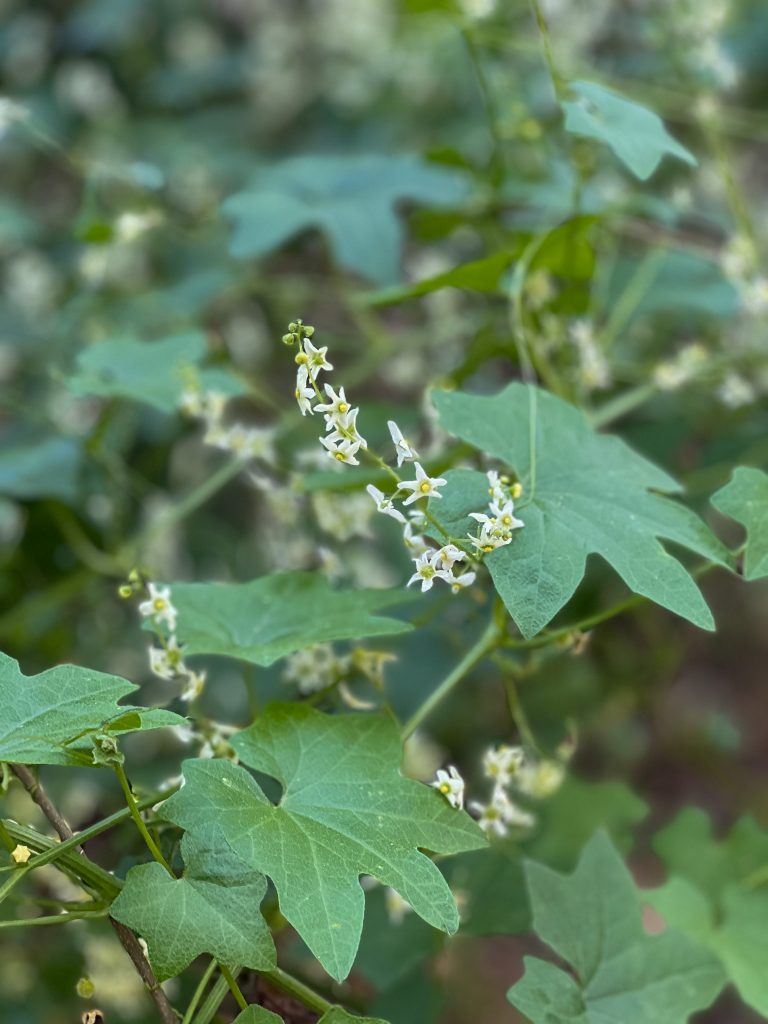
The fruit is a round, spikey ball that grows throughout the spring and ripens in early summer. When ripe, the fruit splits (dehisces) and the seeds pop out. They are not edible and can induce vomiting and diarrhea if digested. Interestingly, Native Americans brewed the leaves as a tea that has been used to relieve stomach problems and nausea.

This native plant’s tubers are soapy (containing saponins) and have been, used to bring fish to the surface of a pond. Soaproot (soap plant) and California buckeyes are also use for fishing in the same manner.
California Buckeye
California Buckeyes are common throughout in Bidwell Park. This drought tolerant California native plant is typically the first deciduous shrub to leaf out in the rainy season in December and January and the first shrub/tree to lose their leaves in summer (July – August) when they become water stressed. In Lower Park they are apparent as few other plants have leafed out yet. In the summer they well hidden and blend in with the other shrubs, until they flower and their yellowish-white florescence crown the entire canopy of the shrub in a colorful display of their flowering prowess.
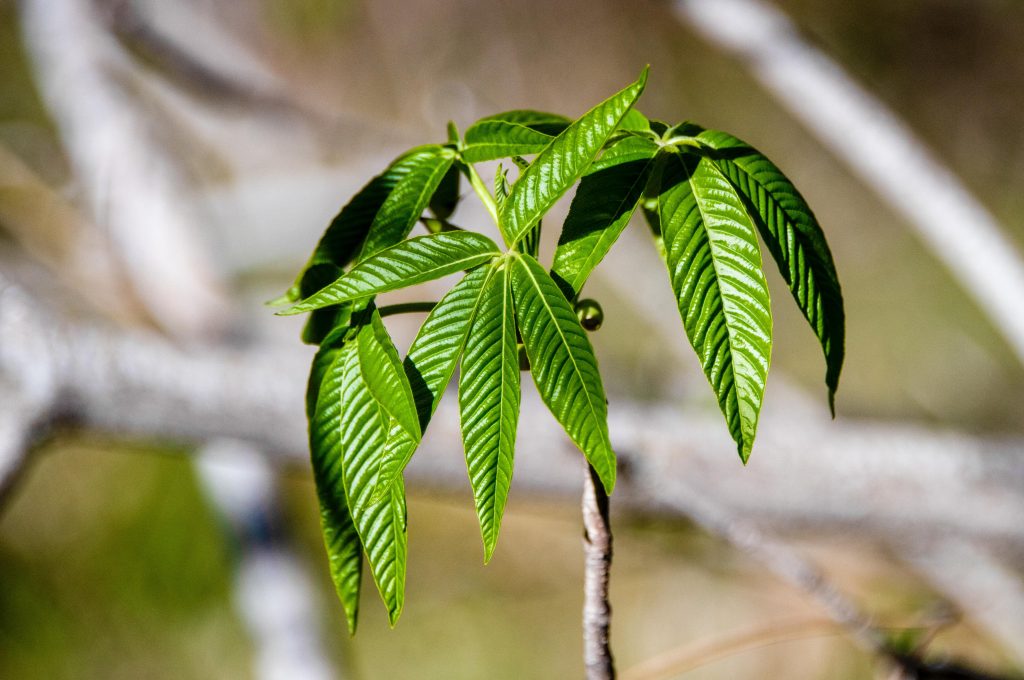
The shrub is a multi-branched shrub starting at its base, as most shrubs are. Chico’s Vegetation Fire Management Plan suggests that multi-branched shrubs, like the California Buckeye and California Bay, be trimmed to remove all but one branch/trunk to make it “fire-resistant” with less material to burn. This would be a major mistake and I hope it doesn’t come to pass.
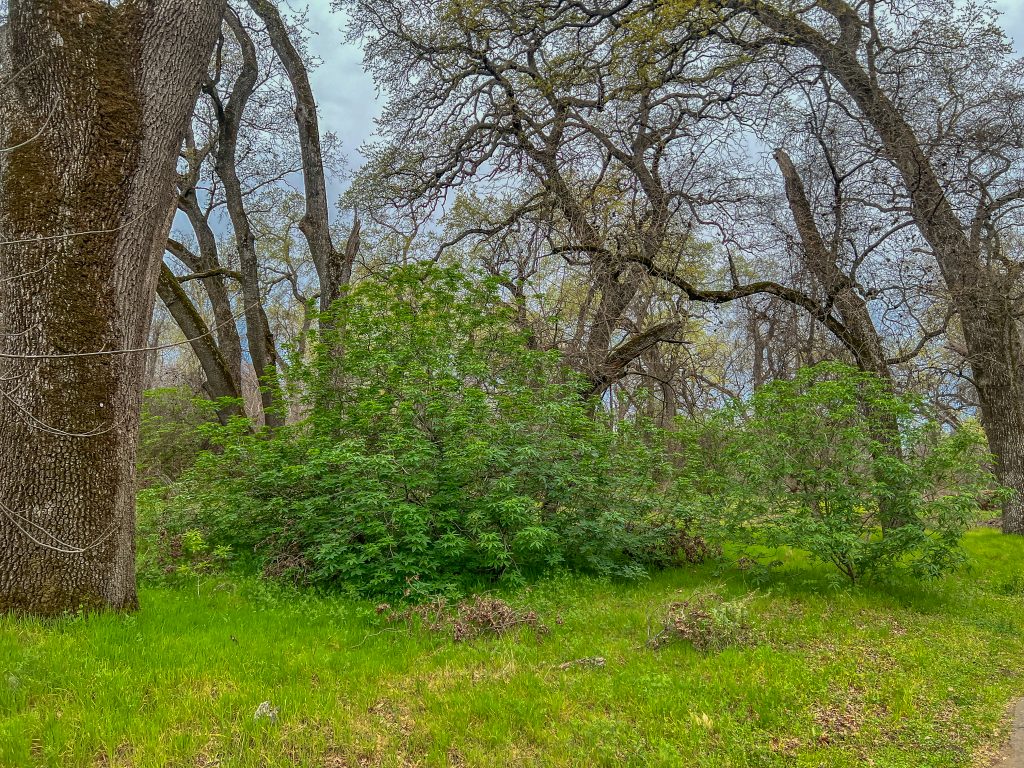
Some of the Buckeyes in the Park have been severely pruned by CCC crews in the winter of 2020 for no apparent reason other than to “lift” the shrub to somehow prevent fires getting into the canopy of the oaks, even though there were no oaks near the Buckeyes that were “lifted”. The picture below shows a severely pruned (“lifted”) Elderberry and California Buckeye. The Buckeye is behind the Elderberry and was hacked up pretty good by the poorly supervised CCC crews. The Elderberry hasn’t recovered while the Buckeye has somewhat.

The California Buckeye flowers in mid-spring and can be quite showy with white panicles of flowers adorning the entire shrub. In the shade of Lower Park oaks the blossoms are not quite as showy or as impressive as the California Buckeyes in the Upper Park or along Highways 32 and 70. Look for these flowers next month when you are in Lower Park.
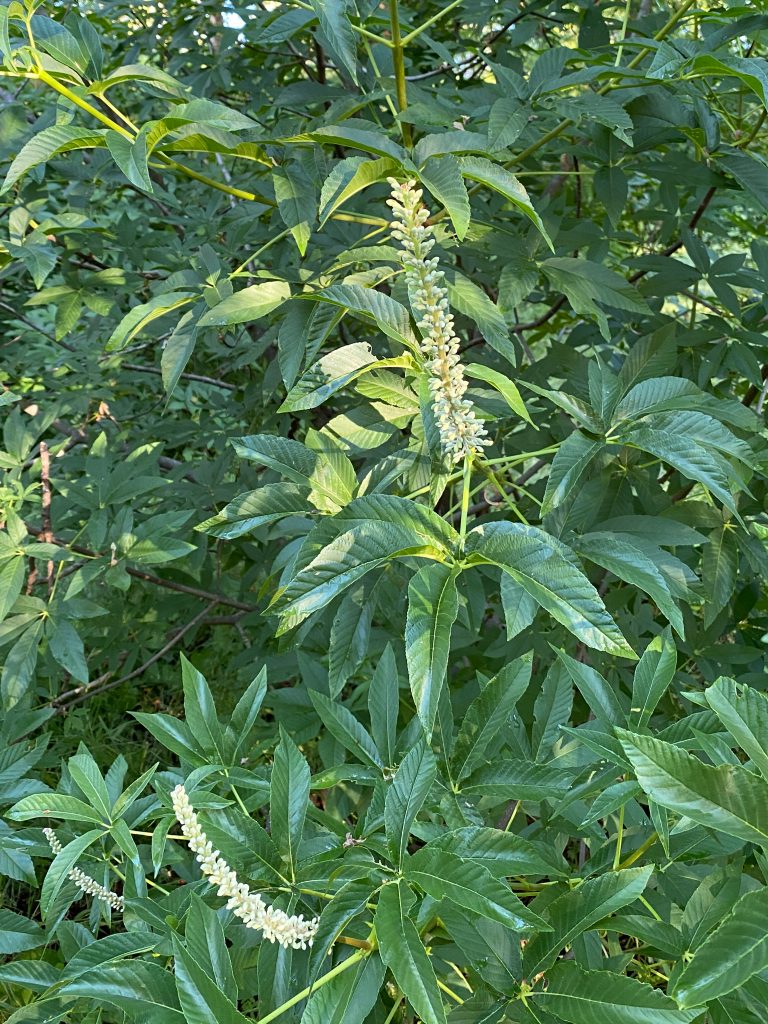
California Buckeye flowers are pollinated by native bees but are toxic to the common honeybee (honeybees, Apis melliferi, are imported from Europe and not native). Plant stems, leaves and seeds are poisonous to people and animals. However, if properly prepared, by leaching, the seeds can be used as an emergency source of food. The seeds were used by Native Americans to “stupefy” fish, similar to the Valley Manroot and Soaproot, when placed in ponds and allow the fish to be easily caught by hand.
Despite all of the flowers the Buckeye doesn’t produce very many fruits. In fact, typically only two seed pods, each with one seed, that look like a buck’s eye, hence the name, are produce for each flowering panicle.

The other notable feature about this shrub is that is is the first shrub/tree to turn brown and lose its leaves. Being totally adapted to California’s Mediterranean climate, the California Buckeye is summer deciduous, that is, it loses its leaves in the summer when things dry up. In August all the leaves are brown and and drop off. By September all that is left on the trees are the fruits in their husks which will pop open (dehisce) to allow the see to drop to the ground where it will germinate when the rains come.
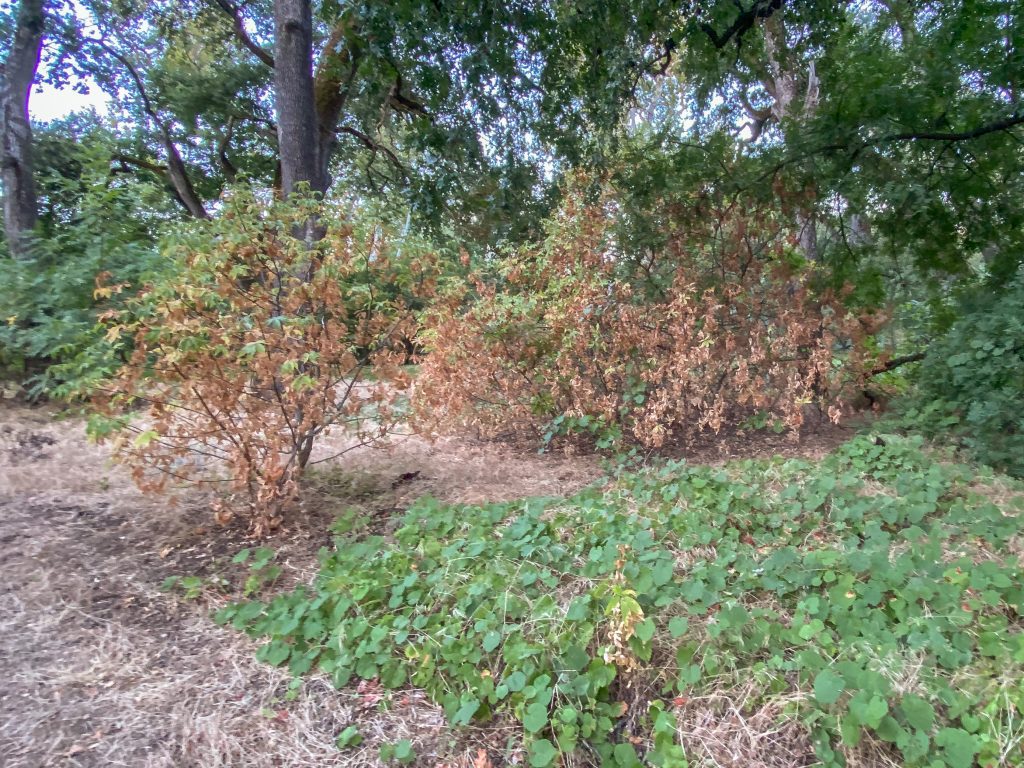
On your walks through the Park, Upper and Lower, keep an eye out for the California Buckeye.
Soaproot Plants
As I make reach the apex of my loop in Lower Park and head back towards the Bryant Avenue entrance/exit I take the middle trail between Petersen Drive and the Par Course trail along Vallombrosa. The narrow middle trail winds through the Lower Park for a couple miles and is a nice alternative trail, when the poison oak isn’t growing into the trail. Just past the Mardone Avenue Trail is a meadow, actually more of an open without oaks. This vegetation in this area is mostly ground cover with two native, Coyote Bush (Baccharis pilularis) shrubs, growing in the middle (another target of the City’s vegetation fire plan because they are shrubs). At this time of year, March, it is covered by vetch and popping up through the vetch everywhere are native Soaproot plants (Chlorogalum pomeridianum).
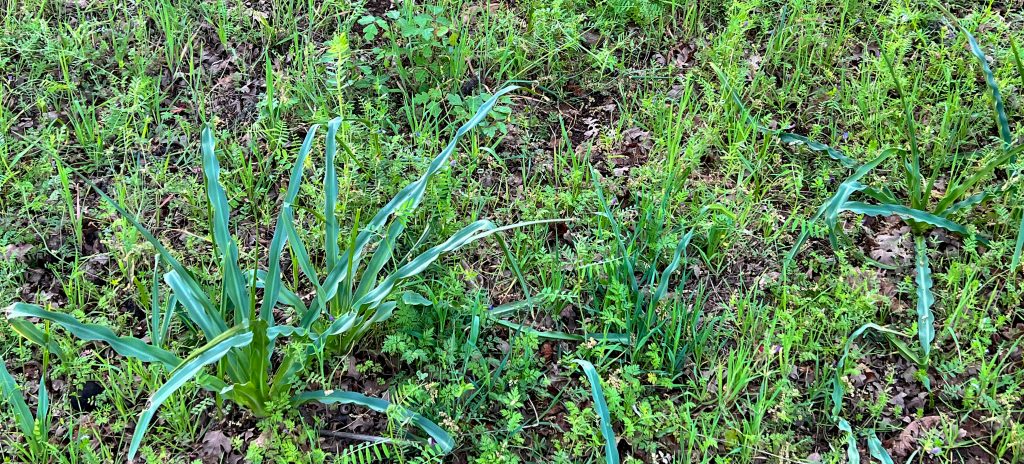
Soaproot, or as it is also known as “soap plant”, “wavyleaf soap plant”, or “amole” in endemic throughout California and is a member of the lily family. The long wavy leaves are easy to identify and the plant’s most recognizable feature. Many people recognize plants by their flowers, and while these plants flower, they flower in the evening, a characteristic known as “vespertine”. They send up a very tall flower stalk (3 – 6 feet high or more) in mid-summer (June) before they die back from heat and lack of water. In fact, their species name “pomeridianum” is derived from post meridiem or “past mid-day”. They only stay open one night and are gone the next day.
I was told by someone that soaproot only flowers at night in the moonlight. One moonlit night in June I headed into Lower Park with a flashlight to check out the soaproot flowers in the moonlight, sure enough they were open. However, a few days later on a late evening walk, just after sunset, in the Park I discovered that the flowers opened at that time too and without moonlight. If you want to see them bloom you will have to pay attention to when the flower stalks pop up and notice when the flowers start to bud, usually late May or early June. Fortunately, they do not flower at exactly the same time, but within a couple weeks of flowering they are done. That gives you time to check out their flowers once they start blooming.
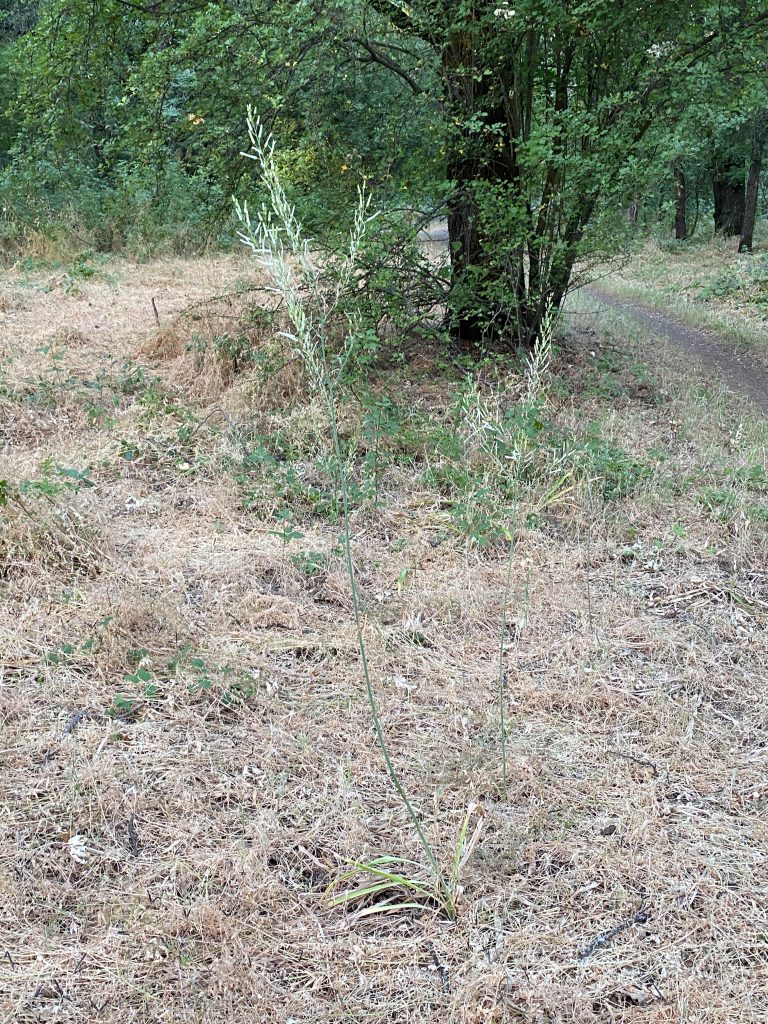
Soaproot is/was a very important plant for California’s indigenous peoples. It is/was used by native peoples for a variety of different things. It gets its name “soaproot” because when the bulb is crushed and massaged with water the bulb becomes soapy and can be used to wash clothes, hair, body parts, or anything else that needs washing. The fibrous bulb can be used as a scratch pad to scour pots and pans or hands.
The bulb was also a food source. According to Wes Dempsey bulbs were dug out of the ground, collected, and cooked in a rock-lined fire pit after the rocks were heated up and the embers removed. More hot rocks piled top of the bulbs. After being heated the first material that oozed out was sticky and used as glue for gluing feathers to arrow shafts. With continued roasting the bulb became edible.
The bulb was also used to stupefy fish, just like California Buckeye and Valley Manroot. Thrown into a pond the crushed bulbs would leach and chemicals cause the fish to rise to the surface where they could be easily caught. Wes said it blocked oxygen uptake in the fish’s gills and they would float to the surface.